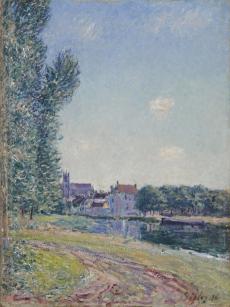


The date of this landscape should probably be read as 1888 due to the existence of similar compositions painted in the same year; it is not far removed in time from his Un Verger (see AGLG 376), and their styles remain close. It is part of an important series of views of the small town of Moret-sur-Loing, whose church steeple, often depicted by the painter in other works, is especially recognisable in the background. Changing his point of view, depending on whether he sat on one or the other riverbank, closer or further from the church, Sisley described at length the tree-lined banks of the Loing. This Vue de Moret is not included in the catalogue raisonné of Sisley’s works published in 1959 by François Daulte, but, according to the sale catalogue of 1963,1 Daulte himself ‘stated that this is a view of Moret and the river Loing and was probably painted in 1888’. Indeed, it can be considered to be a sort of close-up of compositions painted by Sisley in 1888,2 an effect that is emphasised by the use of a tall format, less customary in his panoramic views of the river. A similar point of view is found in a series of compositions dated 1892 and entitled Matrat’s Boatyard, Moret-sur-Loing (for example, Le Chantier à Matrat, Moret-sur-Loing, Temps Pluvieux; New Haven, Yale University Art Gallery).
Questioned about his conception of art by his admirer and biographer Adolphe Tavernier, Sisley expounded in a letter dated 24 January 1892 on what he called a ‘landscape course’, which sheds light particularly on the contemplation of Vue de Moret: ‘Interest in a canvas is manifold. The subject, the motif should always be rendered in a simple, comprehensible, gripping way, in regard to the viewer. He [the viewer] should be led, through the elimination of superfluous details, to follow the path that the painter is showing him and to see, first of all, what it was that grabbed him. […] After the subject, the motif, one of the most interesting aspects of the landscape is that of movement; of life. And it is also one of the most difficult to capture. To give the illusion of life is for me the most important thing in an artwork, everything should contribute to this: form, colour, method of execution. […] Objects must be rendered in their own texture; also, and most importantly, they must be enveloped in light. […] It’s the sky that should be the means. The sky cannot be a mere background, on the contrary, it contributes not only to giving depth thanks to its planes (because the sky has planes, just as the land does), it also gives movement through its form, and through its arrangement in relation to the effect or the composition of a painting. […] I always begin a canvas with the sky.’
He was born in Paris to English parents. A friend of Frédéric Bazille, Pierre-Auguste Renoir and Claude Monet from around 1863, Sisley briefly studied painting in the studio of Charles Gleyre, but was essentially selftaught. He was one of the first Impressionist painters. Primarily a pure landscape artist, he always lived near Paris, never far from the Seine; the river was a main motif in his work, along with the surrounding countryside, particularly at Moret-sur-Loing. He remained dedicated to the Impressionist aesthetic and to painting en plein air throughout his career.